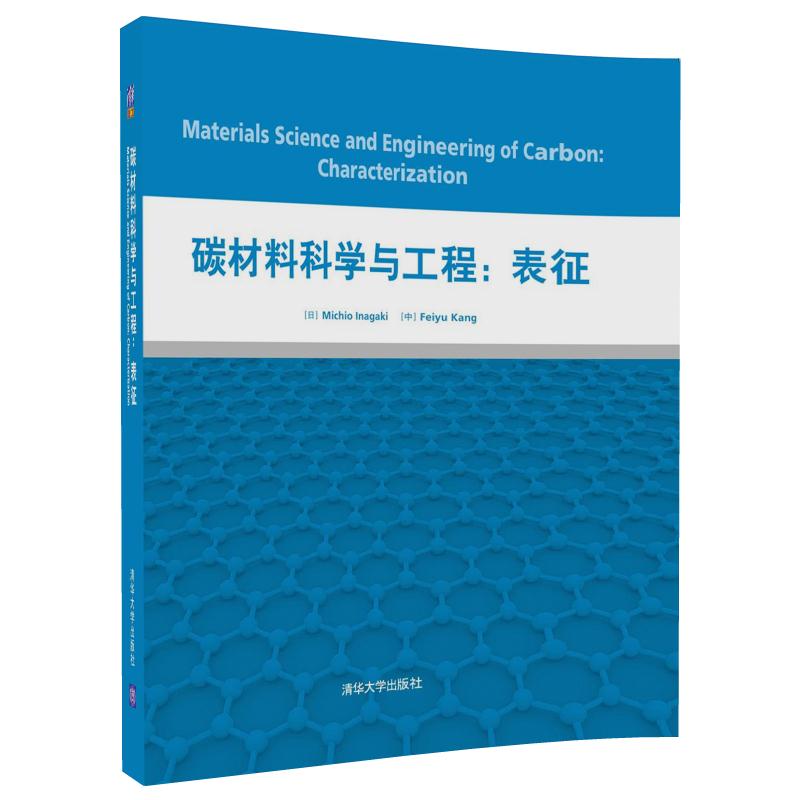內容簡介
碳材料由於其結構多樣性,導致其性能多樣化,因而套用領域廣闊,碳材料研究已受到全球材料科學界、物理學界、化學界的廣泛關注。本書系統介紹了碳材料表征技術及套用,包括X射線粉末衍射、小角X射線散射、透射電鏡、掃描電子顯微鏡、圖像分析、拉曼光譜、X射線光電子能譜、磁電阻、電化學性能、氣體吸附/解吸等溫線、熱分析、表面官能團滴定測定、程式升溫脫附技術。本書讀者對象為材料領域的科技人員、研究生和高校教師。本書以英文著述,並與Elsevier出版集團合作已在海外出版。
作者簡介
MichioInagaki教授,日本北海道大學榮休教授。擔任過日本碳素學會主席,JSPS117委員會主席,Carbon雜誌副主編。獲得過美國和中國碳素學會、日本陶瓷學會學術貢獻獎。出版8本書,發表700多篇學術論文。FeiyuKang(康飛宇),教授,清華大學深圳研究生院院長。現任SCI刊物《Carbon》顧問編委,SCI刊物《新型炭材料》副主編,層間化合物系列國際會議(ISIC)國際顧問委員會委員。曾獲國家發明獎等多項獎勵。出版中英文專著5部,在國內外發表論文200多篇。
目錄
ListofContributors
Preface..
Acknowledgments..
CHAPTER1Introduction1
MichioInagaki,FeiyuKang
1.1CarbonMaterials1
1.2CharacterizationofCarbonMaterials3
1.3StructureofthePresentBook.5
References6
CHAPTER2X-rayPowderDiffraction..7
NorioIwashita
2.1Introduction.7
2.2X-rayDiffractionPatternofCarbonMaterials8
2.3ParametersDeterminedbyX-rayDiffraction.10
2.4Instrumentation.11
2.5SpecificationsforMeasurement14
2.5.1PreparationofSampleforX-rayMeasurements14
2.5.2MeasurementandIntensityCorrectionofDiffraction
Profiles14
2.5.3CorrectionofDiffractionAngleWithInternal
Standard.16
2.5.4DeterminationofFullWidthatHalfMaximum
Intensity.17
2.5.5AccuracyoftheValuesDetermined.18
2.6DegreeofGraphitization18
2.7KeyIssuesforMeasurement..21
2.7.1DiffractionPattern21
2.7.2UseofInternalStandard.21
2.7.3UseofThinSampleHolder22
2.7.4IndexingtheDiffractionLine23
2.7.5SeparationintoComponentProfiles.23
2.8ConcludingRemarks24
References..24
CHAPTER3Small-AngleX-rayScattering.27
KatsuyaFukuyama,YoshikiyoHatakeyama
3.1Introduction27
3.2Fundamentals28
3.3KeyIssuesfortheMeasurements.33
3.4ApplicationsforCarbonMaterials35
3.4.1PorousCarbonFibers..35
3.4.2Glass-LikeCarbons.36
3.4.3MesocellularFoamCarbons(Silica-Templated
Carbons).38
3.4.4OpenPoresFormedbyAirOxidation.40
3.5ConcludingRemarks42
References..42
CHAPTER4TransmissionElectronMicroscopy..45
SylvieBonnamy,Agne`sOberlin
4.1Introduction45
4.2ModesofTransmissionElectronMicroscopy46
4.2.1DiffractingMode..47
4.2.2ImagingModes.47
4.3KeyIssuesforObservation48
4.3.1ObjectThickness(WeakPhaseObject)..48
4.3.2ContrastTransferFunctionoftheTransmission
ElectronMicroscope49
4.3.3DiffusionContrasts..54
4.3.4FresnelFringes,ie,EdgeFringes.54
4.5ApplicationsforCarbonMaterials56
4.5.1TransmissionElectronMicroscopyModestoStudy
CrystallinityofCarbonMaterials.56
4.5.2TransmissionElectronMicroscopyModesin
theStudyofCarbonizationandGraphitization.62
4.6Conclusions69
References..69
FurtherReading.70
CHAPTER5ScanningElectronMicroscopy.71
AkiraYoshida,YutakaKaburagi,YoshihiroHishiyama
5.1Introduction71
5.2InstrumentationandResolvingPower.72
5.2.1Instrumentation.73
5.2.2MagnificationandResolvingPowerofthe
ScanningElectronMicroscope..75
5.2.3EdgeEffectsAppearinginSEModeImages.76
5.3SpecimenPreparation..77
5.4ObservationWiththeOut-LensObjectiveLensSystem.79
5.5ObservationWiththeSnorkelObjectiveLensSystem.81
5.6ObservationWiththeIn-LensSystem.82
5.7ElectronChannelingEffect83
5.7.1ElectronChannelingEffectforKishGraphite..83
5.7.2ElectronChannelingPatternforKishGraphite
andHOPGSpecimens.86
5.7.3MappingandCrystalGrainSizeEvaluation..88
5.8ConcludingRemarks91
References..92
CHAPTER6ImageAnalysis95
KyoichiOshida
6.1Introduction95
6.2ImageAnalysisMethods96
6.2.1ProcessofImageAnalysis.96
6.2.2AnalysisofSpaceFrequency.97
6.2.3Three-DimensionalTransmissionElectron
Microscopy..100
6.2.4SoftwarefortheAnalysis.100
6.3StructureAnalysisThroughTransmissionElectron
Microscopy.101
6.3.1Cup-StackedTypeCarbonNanotubes101
6.3.2CarbonNanotubesLoadedWithMetalParticles.104
6.3.3ThinGraphite..108
6.3.4DisorderedCarbon.108
6.4TextureAnalysisThroughScanningElectron
Micrographs113
6.5TextureAnalysisThroughOpticalMicrographs.116
6.6ConcludingRemarks.120
References121
CHAPTER7RamanSpectroscopy..125
YutakaKaburagi,AkiraYoshida,YoshihiroHishiyama
7.1Introduction.126
7.2Fundamentals.126
7.3KeyIssuesfortheMeasurements..129
7.3.1LaserProbeSamplingDepth129
7.3.2PolarizationofLaserLight..129
7.3.3SamplingArea.131
7.3.4Temperature.132
7.3.5EliminationofBackgroundIntensity.132
7.3.6ExcitationEnergyDependenceofDBand133
7.3.7CalibrationofRamanFrequency.134
7.3.8Equipment136
7.4AsaMeasureforStructureCharacterization..138
7.4.1GBand..138
7.4.2DandD0Bands..141
7.5ConcludingRemarks.149
References150
CHAPTER8X-rayPhotoelectronSpectroscopy153
HidetakaKonno
8.1Introduction.153
8.2PracticalSideofMeasurements.154
8.3StateAnalysis.156
8.3.1DeterminationofBindingEnergy156
8.3.2BackgroundSubtraction158
8.3.3PeakSeparation..159
8.3.4StateAnalysisUsingChemicalShift.164
8.4SemiquantitativeAnalysis166
8.5ConcludingRemarks.168
References169
CHAPTER9Magnetoresistance..173
YoshihiroHishiyama,YutakaKaburagi,MichioInagaki
9.1Introduction.174
9.2GeneralSchemeofDr/r0ChangeWithGraphitization174
9.3MeasurementofMagnetoresistance..178
9.3.1SpecimenShape..178
9.3.2MagneticFieldOrientationSchemes.179
9.3.3Instruments..182
9.4MagnetoresistanceParametersforCoke..185
9.4.1CokeBandGilsoniteCoke..185
9.4.2CokePreparedFromHydrogenatedEthylene
TarPitch186
9.5MagnetoresistanceParametersforCarbonFibers
andExtrudedCoke189
9.5.1Benzene-DerivedVapor-GrownCarbonFiber
andExtrudedCoke.189
9.5.2OtherCarbonFibers..191
9.6MagnetoresistanceParametersforHighlyCrystallized
GraphiteMaterials.192
9.7ConcludingRemarks.194
Supplement:BackgroundoftheCharacterizationofCarbon
MaterialsWithDr/r0195
S-1OriginoftheSignofDr/r0..195
S-2Microtexture197
S-3RelationshipBetweenMicrotextureandMagnetoresistance.199
References203
CHAPTER10ElectrochemicalPerformance..205
SoshiShiraishi
10.1Introduction..205
10.2Fundamentals206
10.2.1Capacitance.206
10.2.2ConstructionofMeasurementCell.208
10.2.3ElectrochemicallyAnalyticalMode..209
10.2.4DifferentialCapacitanceandIntegral
Capacitance.211
10.2.5DefinitionofSpecificCapacitance.212
10.3MeasurementProcedure.214
10.3.1MeasurementCell..214
10.3.2PreparationofCarbonElectrode.216
10.3.3AqueousAcidElectrolyteSystem
(byThree-ElectrodeCell).218
10.3.4OrganicElectrolyteSystem
(byThree-ElectrodeCell).219
10.3.5OrganicElectrolyteSystem
(byTwo-ElectrodeCell)..221
10.4ConcludingRemarks..224
References224
CHAPTER11GasAdsorption/DesorptionIsotherm
forPoreStructureCharacterization227
YokoNishi,MichioInagaki
11.1Introduction..228
11.2Fundamentals229
11.3KeyIssuesfortheMeasurementsandAnalyses..232
11.3.1SampleAmountfortheMeasurement..232
11.3.2PretreatmentofSample.232
11.3.3BrunauereEmmetteTellerMethod233
11.3.4asPlot..234
11.3.5BarretteJoynereHalendaMethod..235
11.3.6DubinineRadushkevichMethod.237
11.3.7DensityFunctionalTheoryMethod238
11.4ApplicationtoCarbonMaterials.239
11.4.1MicroporousCarbons239
11.4.2MesoporousCarbons.241
11.4.3MeasurementsUsingVariousGasesasAdsorbate.243
11.4.4GravimetricMeasurementofAdsorption/
DesorptionofCO2.244
11.5ConcludingRemarks..245
References246
CHAPTER12ThermalAnalysis..249
Ming-mingChen
12.1Introduction..249
12.2FundamentalsinThermalAnalyses250
12.3KeyIssuesfortheMeasurements252
12.4ApplicationsofTGandDTGforCarbonMaterials256
12.4.1Biomasses256
12.4.2Pitches..258
12.4.3OrganicPolymers..258
12.4.4MeasurementsinOxygen.263
12.5ApplicationsofDTAandDSCforCarbonMaterials.265
12.5.1Pitches..265
12.5.2OrganicPolymers..267
12.5.3IntercalationReactions.269
12.6ConcludingRemarks..269
References270
CHAPTER13TitrationMethodfortheIdentification
ofSurfaceFunctionalGroups273
YernSeungKim,ChongRaePark
13.1Introduction..273
13.2BasicConceptofTitrationMethod.276
13.3Instrumentation279
13.4SpecificationfortheMethodology..279
13.4.1ReactionStep..280
13.4.2FiltrationStep.281
13.4.3TitrationStep..281
13.5AnalysisoftheTitrationResults.281
13.6KeyPointsfortheTitrationMeasurements..284
13.6.1PreparationoftheReactionMixturefortheReaction
Step284
13.6.2AgitationMethodandPeriod..284
13.6.3TitrationConditionandEndPointDetermination..285
13.7ConcludingRemarks..285
References285
CHAPTER14TemperatureProgrammedDesorption287
TakafumiIshii,TakashiKyotani
14.1Introduction..287
14.2TPDExperimentalConditionsandApparatus..288
14.3AssignmentofTPDPeakstoSurfaceFunctional
Groups291
14.4SecondaryReactionsDuringaTPDRun..296
14.5EffectofAirExposureonTPDPatterns299
14.6EffectofInorganicMatterinCarbons300
14.7ConcludingRemarks..302

